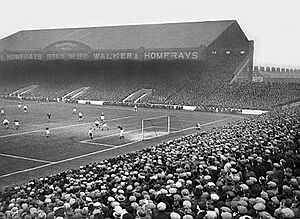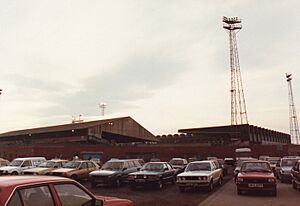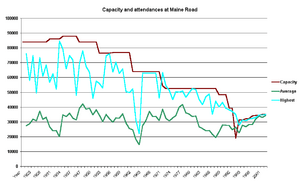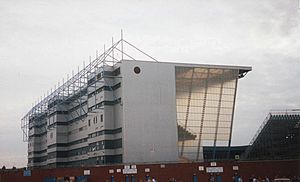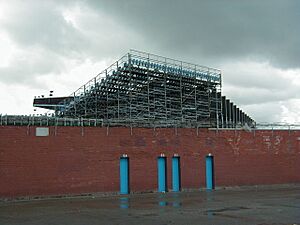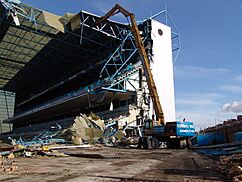Maine Road facts for kids
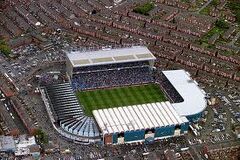
Aerial view of Maine Road on 11 May 2003, the day of the final match
|
|
| Location | Moss Side, Manchester, England |
|---|---|
| Coordinates | 53°27′4″N 2°14′7″W / 53.45111°N 2.23528°W |
| Owner | Manchester City |
| Operator | Manchester City (1923–2003) |
| Capacity | 35,150 (at closure) 84,569 (record) |
| Construction | |
| Built | 1923 |
| Opened | 1923 |
| Renovated | 1931, 1957, 1970, 1994 |
| Expanded | 1935 |
| Closed | 2003 |
| Demolished | 2004 |
| Construction cost | £100,000 |
| Architect | Charles Swain |
| Structural engineer | Sir Robert McAlpine |
| Tenants | |
| Manchester City (1923–2003) Manchester United (1945–1949, 1956–1957) |
|
Maine Road was a famous football stadium in Moss Side, Manchester, England. It was the home ground for Manchester City for 80 years, from 1923 to 2003.
This stadium hosted many important football matches. These included FA Cup semi-finals, the Charity Shield, a League Cup final, and games for the England national team. Maine Road set a record for the highest attendance at an English club ground. In 1934, 84,569 fans watched Manchester City play Stoke City in an FA Cup match.
When it closed in 2003, Maine Road was an all-seater stadium. It could hold 35,150 people. The stadium looked a bit mixed up because different parts were built and changed over its 80-year history. After Maine Road closed, Manchester City moved to the City of Manchester Stadium (now known as the Etihad Stadium). This new stadium is in east Manchester, closer to where the club first started in 1880.
Contents
History of Maine Road
Why Manchester City Moved
Manchester City decided to build Maine Road in May 1922. Their old stadium, Hyde Road, was too small to make bigger. Also, a big fire had badly damaged its main stand in 1920.
The club looked at two places in Belle Vue in east Manchester. Many fans thought east Manchester was City's true home. However, these sites were not big enough. The club needed more space for a new, larger stadium. So, they chose a site in Moss Side instead.
Building the Stadium
Manchester City bought a 16.25-acre piece of land for £5,500. This land used to be a brickworks. The road next to it was called Dog Kennel Lane. It was renamed Maine Road in the 1870s. This new name came from the "Temperance movement," a group that owned land there.
Building the stadium took 300 days and cost £100,000. At first, it had one covered stand with 10,000 seats. The other three sides had open standing areas. There's an old story, probably just a myth, that a Gypsy cursed the stadium during its construction.
Early Games and Record Crowds
The very first match at Maine Road was on August 25, 1923. A huge crowd of 58,159 fans watched Manchester City beat Sheffield United 2–1. The stadium was first changed in 1931. A corner between the Main Stand and the Platt Lane end got a new roof.
In 1934, Maine Road saw the biggest crowd ever for an English football club playing at its home stadium. On March 3, 1934, 84,569 fans came to watch Manchester City play Stoke City in the FA Cup. People started lining up four hours before the game! Manchester City won that exciting match 1–0.
More changes happened in 1935 at the Platt Lane end. The standing areas were made bigger and covered with a roof. At this point, the stadium could hold about 88,000 people. Plans for even more changes were stopped when World War II began.
After World War II
After World War II, Manchester United shared Maine Road for a few years. Their own stadium, Old Trafford, was damaged during the war. Manchester United paid City to use the stadium. During this time, the highest attendance for a league game at Maine Road was recorded. On January 17, 1948, 83,260 people watched Manchester United play Arsenal. This is still a national record for a league match.
Changes from the 1950s to 1980s
Floodlights were added to Maine Road in 1953. More improvements were made in 1957. The stand opposite the Main Stand was rebuilt and named The Kippax. This area became known for the club's most passionate fans. In 1963, benches were put in at the Platt Lane end. This meant Maine Road had more seats than any other English club stadium then.
In the 1970s, the North Stand was built. It had a special roof that stuck out without needing support poles. This stand stayed until the stadium closed. There were big plans for more upgrades in the 1980s, but they were put on hold because of money problems.
Making Maine Road Modern
By 1990, some parts of the stadium were getting old. Also, new rules meant all stadiums had to have only seats, no standing areas. So, the Platt Lane stand was knocked down in 1992. A new all-seater stand, called the Umbro Stand, opened in its place in 1993. It also had special boxes for important guests.
The last day for standing areas at Maine Road was in May 1994. The Kippax Street Terrace, a large standing area, was demolished. A new three-tier stand was built there, holding almost 14,000 fans. When it was finished in 1995, it was the tallest stand in England. This new stand cost £16 million. The club had plans to make the stadium even bigger, but these were stopped when Manchester City was relegated from the top league in 1996.
The new Kippax Stand looked very modern. However, it also showed how different parts of the stadium were built at different times. Each side had a different height and style.
The Final Match and New Home
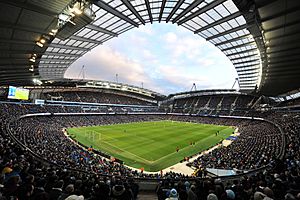
There were ideas to make Maine Road even bigger, to hold 45,000 seats. But instead, the club decided to move to the City of Manchester Stadium. This new stadium was built for the 2002 Commonwealth Games.
The last official football match at Maine Road was on May 11, 2003. It was a Premier League game against Southampton. Almost 35,000 fans filled the stadium for this special day. City lost the match 1–0, and Michael Svensson scored the very last goal at Maine Road. After the game, there were concerts by bands like Badly Drawn Boy and Doves.
Manchester City's last goal at the stadium was scored earlier, on April 21, 2003. Marc-Vivien Foé scored it in a 3–0 win against Sunderland. Sadly, Foé passed away just 66 days later while playing for his country.
In July 2003, an auction was held to sell parts of the stadium. Things like seats and signs were sold. It raised £100,000, which was given to community projects in the Moss Side area.
What Happened to the Site
After Manchester City moved out, some people suggested other sports teams could use Maine Road. However, none of these ideas worked out. The stadium started to be knocked down in late 2003. This process took about 10 months.
Two years later, plans were approved to build new homes on the site. Now, there are 474 homes there. There's also a public art display that remembers the stadium. It has a circular plate, like the center spot of the pitch, showing the new development that stands there today.
The Pitch at Maine Road
For many years, Maine Road had the widest football pitch in England. Managers sometimes changed the width to suit how they wanted their team to play. In its final season, the pitch was 107 meters long and 71 meters wide. The new City of Manchester Stadium has continued this tradition of having a large pitch.
Other Uses of the Stadium
Maine Road was not just for Manchester City games. It hosted two international matches for the England team. It also held many rugby league matches, including the Rugby Football League Championship Final several times.
Manchester United used Maine Road for some of their European Cup games in 1956-57. This was because their own stadium, Old Trafford, did not have floodlights yet. In one of these games, United beat a Belgian team 10-0!
The stadium also hosted many FA Cup semi-finals. The last one was in 1994. It also held the replay of the 1984 Football League Cup final.
Maine Road appeared in a few movies, like Cup-tie Honeymoon (1948) and There's Only One Jimmy Grimble (2000). It was also in the 2003 TV show The Second Coming.
Many famous music artists held concerts at Maine Road. These included Bryan Adams, Bon Jovi, David Bowie, Pink Floyd, Prince, Queen, and The Rolling Stones. The most well-known concert was by the Manchester band Oasis in 1996. This performance was later released as a video.
In 1961, a Christian speaker named Billy Graham spoke at the stadium. Over four nights, more than 100,000 people came to listen to him.
Maine Road Football Club
There is also a non-league football club named Maine Road FC. This club was started in 1955 by a group of Manchester City supporters. They used to have their clubhouse next to the Maine Road stadium.
See also
 In Spanish: Maine Road para niños
In Spanish: Maine Road para niños


